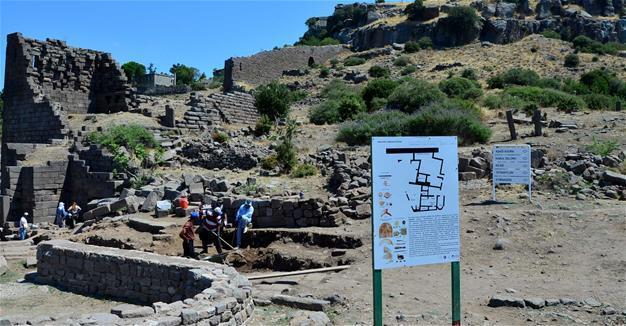Traces of ancient earthquake in Assos
ÇANAKKALE
 Ruins with the traces of a massive earthquake that occurred 1,300 years ago have been unearthed in the ancient city of Assos in the northwestern province of Çanakkale’s Ayvacık district.
Ruins with the traces of a massive earthquake that occurred 1,300 years ago have been unearthed in the ancient city of Assos in the northwestern province of Çanakkale’s Ayvacık district. An important coastal town in the ancient times, the city, where Aristotle founded the first philosophy school, is a popular spot for thousands of visitors every year thanks to its Roman-era theater, agora, necropolis and walls.
Professor Nurettin Arslan, who leads the excavations in the ancient city and the head of Çanakkale Onsekiz Mart University’s (ÇOMÜ) archaeology department, said the new season of excavations started in July.
He said works are continuing around the western gate of the city as well as in a structure served as a public house. “Last year a big Roman-era house was unearthed. It collapsed during an earthquake and all of its rooms were there. We will continue opening the other rooms in the house this year. Works are also continuing in a field we call gymnasium and at the entrance to the agora,” he added.
Arslan said they are working in various fields in the ancient city and the restoration of the artifacts is continuing in parallel with the excavation works.
He said the house, which collapsed during an earthquake, is one of the rare structures in the ancient city.
“There is information in ancient sources about the earthquakes in the region, especially in Lesvos. The walls here are very strong; there is a small chance the collapse of these walls were caused by an earthquake. But since the houses were made of mud and stone in the 7th and 8th centuries, when the earthquake occurred, they easily collapsed. The structures they found here collapsed during an earthquake, too, because all elements of a house such as tables, ground tones and axes still remain in the house. This situation can be explained with an earthquake only. Moreover, we found remains of dead animals in the houses. We estimate that a sudden earthquake caused it,” he added.
Arslan said the remains of roof tiles cover the objects in the house because the roof is the first to collapse in an earthquake. Under these objects are pig and mouse remains as well as tools used in a house, tiles, big grain storages and ground grinders.
“These are very important tools. They remain untouched in the ruins of the house. This is why we think that people escaped from the house during a sudden earthquake. They should have taken all these things with them if they left the house under normal circumstances. This can be explained with a sudden disaster,” he said.
Not common
Arslan said to trace evidence of an earthquake in an ancient city is very difficult, but the chances of obtaining results in Assos were high.
“You don’t have chance to find such evidence about an earthquake in every place. If a house is left as it is, we can find it. But the tools in the house were taken after the earthquake, or the house was restored, you cannot see the traces of this earthquake. It is not common to find the traces of sudden disasters in excavations. It is only possible to detect them in some certain spots,” he said.
Bronze pencil found in Assos
Arslan said a 1,800-year-old pencil was among the latest findings in Assos.
“We found a 1,800-year-old bronze pencil, which is called ‘stylus’ in archaeology. One side of the pencil is sharp and the other is a bit more flat. These pencils were used in that era to take notes and to make accounts on wax tablets. The flat side of the pencil is used to correct the mistakes; it is equivalent to today’s eraser,” he said.
Arslan said the pencil was used by literate people and students in the ancient city. “Poor students mostly used the stylus to write on sand or ceramics. The rich ones used it to write on wax tablets or plaques.
Apart from that, traders and rich people used this pencil to keep their own accounts. But the users of this pencil had to be literate. Not only free people but also slaves used the pencil, too. They used it to keep the accounts of their owners,” he added.
He said the pencils were made up of hard materials like bronze or bone. “Bronze pencils are more general but we also found the ones made of bones in other regions,” he added.
















